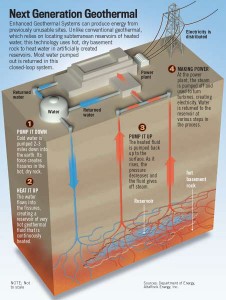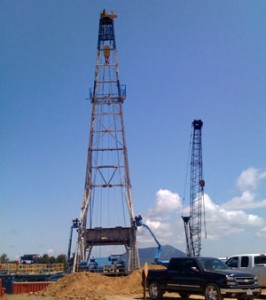Sep
8
AltaRock Loses Its Geothermal Hole
September 8, 2009 | 3 Comments
AltaRock Energy, the company pursuing an advanced geothermal energy technology has had to suspend its first attempt to drill a deep well in Northern California. The effort was funded by Google and venture capital company Kleiner Perkins Caufield & Byers with partial funding by a Department of Energy grant. Some part of the $17 million budget is blown.
The project encountered a number of physical difficulties in the drilling of well called E-7, the first well planned as part of its engineered geothermal systems (EGS) demonstration project in the Geysers, resulting from geologic anomalies particular to the formation underlying the well location. After nearly two months of the highly expensive drilling, the rig had reached a depth of less than 4,000 feet. The original schedule called for it to reach a final depth of 12,000 feet, or 2.3 miles in less than 50 days of drilling.
The problem seems to be the giant rig, meant to drill more than two miles underground, has struggled to pierce surface rock formations. The bit has snapped off at least once and became repeatedly fouled in a shallow formation called cap rock, and the drillers have twice been forced to pull it out and essentially start the hole over again. The problems are particularly surprising as the drilling essentially started at 3,200 feet, at the bottom of an older hole at the site, north of San Francisco.
As they are way behind schedule on Wednesday, the Bureau of Land Management approved a request by AltaRock to halt the drilling operation temporarily, said bureau spokeswoman, Jan Bedrosian, “They need to come back to us with their future plans, and they have not done that.” In a statement, the company confirmed the suspension but gave few additional details. Several industry officials said it was virtually certain that AltaRock would dismantle and remove the expensive rig from the site.
With information of significance missing about the downhole problems one other issue must be having an impact. The media via the lead from The New York Times, has raised questions about whether AltaRock had been forthcoming about a similar project in Switzerland that produced earthquakes. Thus the Bureau of Land Management informed the company that it would not be allowed to fracture rock until the department completed a new review of whether the project would be safe. The company was allowed to keep drilling, however, down toward the depth at which it would begin the fracturing.
The latest delays come as AltaRock awaits word on whether the federal government will allow the fracturing of rock at all. The company has said the fracturing would be virtually guaranteed to induce earthquakes that would be so small as to be nearly imperceptible but which local residents and some scientists fear could be larger. The location at Geyers is in a very active earthquake zone.
The Switzerland project near Basel did trigger small earthquakes and caused only minor structural damage. But the quakes they stimulated frightened many in the city and led to the shutdown of the project there. The Energy Department review, likely to be released in the next few weeks, is expected to compare the Basel and California projects and determine whether AltaRock’s effort is safe enough to proceed.
AltaRock suggests the Basel project made mistakes, primarily drilling in the vicinity of a major known fault that, the company says, was responsible for a huge earthquake that devastated Basel in 1356. Six hundred and fifty or so year back is pretty hard to nail down. Some scientists at the Swiss Seismological Service and other European institutions say the fault responsible for that earthquake has never been clearly identified, let alone localized beneath the geothermal project. Nicholas Deichmann of the Swiss Seismological Service says most of AltaRock’s public statements about that project, “are simply wrong. The Basel project did not drill into any known fault in the area,”
But an AltaRock scientist says the company’s description of the geothermal effort in Basel was based on documents published by scientists both in and outside the project there. Who is right may never be learned if one government agency is going one way while another is going the other. Meanwhile the money is spent and the hole is ‘dry’ for any practical purpose. We are all in the dark.
Technical difficulties are frequent and normal in drilling projects of any kind. The progress of AltaRock is significant because it is one of few companies pursuing enhanced, or engineered, geothermal systems. It’s a technology that holds great promise whether going to depth and injecting water into fractured rock so hot the result is steam for turbine drives or simply cycling gas for binary generation.
Two years ago the Massachusetts Institute of Technology study calculated an enhanced method of geothermal power generation could supply 10% of the electricity in the United States. There are also a wide variety of locations, beyond just the limited number of locations that have today’s customary geothermal resources. Add in the binary generation techniques using lower temperatures and that 10% gets much larger.
AltaRock and its funding partners have an opportunity to learn and produce a great deal op power if the media, public relations, and technology problems can be solved. But the hole has to be drilled, the tests ran and the equipment ran to know.
Maybe there is cause for an earthquake alarm to be raised, but exactly when and why to raise such an alarm is yet to be known with any predictive accuracy. It seems the trial is worthwhile, but has the risk been measured as well? Its just allegations against the science of our time, maybe we should see, and improve the science.
For now the geothermal folks might give some more thought to the binary generation and the drilling locations that might be less difficult. There is a lot of heat down there and the game isn’t really a particular technology, it’s a cost per kilowatt-hour produced vs. the price at the grid that matters.
Comments
3 Comments so far




Its interesting to read an article about the “possible” risk of earthquakes as a result of “fracturing” rock – translation – exploding rock below the surface – in an area full of earthquake faults and a dormant volcano – when you are one of the people who live there. I wonder if the the folks who gave money to this project lived at the base of a dormant volcano surrounded by earthquake faults they would allow such a thing? Oh wait – they do – does anyone really think the faults in Northern California are not connected to faults elsewhere – the answer is no one knows for sure what will happen – or when it might happen – no one. As the folks at AltaRock sit in their comfortable conference room discussing how to save our planet with “clean” energy translation: how to hang onto the mountain of VC and taxpayer money they got – we sit in our homes wondering when the quakes will start. Be honest – no matter what research reports are produced about the “safety” of such projects – no one really knows for sure. So be honest about the risk you are putting those who live in the area and who knows how many more in. If it was your family living near your drill – would you feel the same?
Thanks for some quality points there. I am kind of new to online , so I printed this off to put in my file, any better way to go about keeping track of it then printing?
This is the topic close to my heart cheers, where are your contact details though?